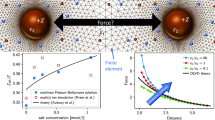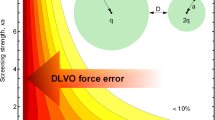Abstract
The DLVO theory of colloidal particle interactions has been at the core of colloid science for a long time. Quantitatively, agreement between experiment and theory was illusory except at salt concentrations less than about 10-2 molar. The same problem with theory exists for pH measurements, buffers, electrochemistry, zeta potentials, electrolyte activities, interfacial tension of salt solutions and a host of phenomena that depend on so called specific ion effects, This is so, most dramatically in biology, but also in colloid, polymer and surface science generally. The problems date back to Hofmeister whose work stands in the scheme of things as Mendel’s did to genetics. Where problems occurred we have tended to argue them away, capturing specificity in unquantifiable terms embodied in words like cosmotropes, chaotropes, hydrophilicity, hydrophobicity, soft and hard ions, pi-cation interactions, hydration and hydrophobic forces, water structure. To complicate the puzzle further the role of dissolved atmospheric gas or other sparingly soluble (hydrophobic) solutes is sometimes major, and has been completely ignored in theories or simulations.
Some progress in unravelling these difficulties has been made. It turns out that theories have been seriously flawed. They depend on an ansatz that separates electrostatic forces from the totality of non electrostatic (NES) quantum mechanical electrodynamic fluctuation (Lifshitz or dispersion) forces. These NES forces are ignored, as for the Born self energy of an ion, or its decorations. Or else the electrostatic forces are treated in a non linear theory (e.g. Poisson Boltzman), and the quantum forces via Lifshitz theory as for DLVO. Even for the continuum solvent approximation this violates both the Gibbs adsorption equation, and the gauge condition on the electromagnetic field.
These problems are highly non trivial and occur equally in quantum field theories and biophysical problems that couple electron and photon transfer.
When the faults are repaired, the revised theory does seem to account for ion specificity and a veritable zoo of postulated new forces begin to fall into place quantitatively. An account will be given of the emerging situation, the role of dissolved gas and “hydrophobic” forces. This leads to new insights into the necessary cooperativity that occurs with water in biological and other systems.
Access this chapter
Tax calculation will be finalised at checkout
Purchases are for personal use only
Preview
Unable to display preview. Download preview PDF.
Similar content being viewed by others
References
Kim H-K, Tuite E, Nordén B, Ninham BW (2001) Co-ion dependence of DNA nuclease activity suggests hydrophobic cavitation as a potential source of activation energy. Eur Phys J E4:411–417
Kékicheff P, Ninham BW (1990) The Double-layer interaction of asymmetric electrolytes. Europhys Lett 12(5):471–477
Nylander T, Kékicheff P, Ninham BW (1994) The effect of solution behaviour of insulin on interactions between adsorbed layers of insulin. J Coll Interface Sci 164:136–150
Waninge R, Paulsson M, Nylander T, Ninham BW, Sellers P (1998) Binding of sodium dodecyl sulphate and dodecyl trimethyl ammonium chloride to beta-lactoglobulin. A Calorimetric Study. Int Dairy J 18:141–148
Pashley RM, Ninham BW (1987) Double-layer forces in ionic micellar solutions. J Phys Chem 91:2902–2904
Bostrom M, Craig VJS, Albion R, Williams DRM, Ninham BW (2003) Hofmeister Effects and the Role of Coions in pH Measurements. J Phys Chem B 107:2875–2877
Salis A, Pinna MC, Bilaniĉova D, Monduzzi M, Lo Nostro P, Ninham BW (2006) Specific anion effects on pH Measurements of Buffer Solutions: Bulk and Surface Phenomena. J Phys Chem B 110:2949–2956
Alfridsson M, Ninham BW, Wall S (2000) Role of cooions and atmospheric gas in colloid interaction. Langmuir 16:10087–10091
Karman ME, Ninham BW, Pashley RM (1996) Effects of dissolved gas on emulsions, emulsion polymerisation and surfactant aggregation. J Phys Chem 100:15503–15507
Vinogradova OI, Bunkin NF, Churaev NV, Kiseleva OA, Lobeyev VA, Ninham BW (1995) Submicrocavity structure of water between hydrophobic and hydrophilic walls as revealed by optical cavitation. J Coll Interface Sci 173:443–447
Bunkin NF, Kochergin AV, Lobeyev AV, Ninham BW, Vinogradova OI (1996) Existence of charged submicrobubble clusters in polar liquids as revealed by correlation between optical cavitation and electrical conductivity. Colloid Surf A: Physicochem Eng Aspect 10:207–212
Bunkin NF, Kiseleva OA, Lobeyev AV, Movchan TG, Ninham BW, Vinogradova OI (1997) Effect of salts and dissolved gas on optical cavitation near hydrophobic and hydrophilic surfaces. Langmuir 13:3024–3028
Bunkin NF, Lobeyev AV, Lyakhov GA, Ninham BW (1999) Mechanism of low-threshhold hypersonic cavitation stimulated by broad band laser pump. Phys Rev E60:1681–1690
Craig VSJ, Ninham BW, Pashley RM (1993) The Effect of Electrolytes on Bubble Coalescence in Water. J Phys Chem 97:10192–10197
Pashley RM, McGuiggan PM, Ninham BW, Evans DF, Brady J (1986) Direct measurements of surface forces between bilayers of double-chained quaternary ammonium acetate and bromide surfactants. J Phys Chem 90:1637–1642
Ninham BW, Evans DF (1986) The Rideal Lecture: Vesicles and molecular forces. Faraday Disc Chem Soc 81:1–17
Karaman ME, Ninham BW, Pashley RM (1994) Some aqueous solution and surface properties of dialkylsulfosuccinate surfactants. J Phys Chem 98:11512–11518
Kunz W, Henle J, Ninham BW (2004) Zur Lehre von der Wirkung der Salze (About the science of the effect of salts): Franz Hofmeister’s historical papers. Curr Opin Coll: Surf Sci 9:19–37
Kunz W, Lo Nostro P, Ninham BW (2004) The Present State of Affairs with Hofmeister effects. Curr Opin Coll: Surf Sci 9:1–18
Lo Nostro P, Fratoni L, Ninham BW, Baglioni P (2002) Water Absorbency by Wool Fibers: Hofmeister Effect. Biomacromolecules 3:1217–1224
Lonostro P, Ninham BW, Lo Nostro A, Pesavento G, Fratoni L, Baglioni P (2005) Specific Ion Effects on the Growth Rates of Staphyloccus aureus and Pseudomonas aeuginosa. Phys Biol 2:1–7
Ninham BW, Yaminsky VV (1997) Ion binding and ion specificity — The Hofmeister effect, Onsager and Lifschitz theories. Langmuir 13:2097–2108
Ninham BW (2002) Physical Chemistry: The Loss of Certainty Progress in Colloid. Polym Sci 120:1–12
Ninham BW, Boström M (2005) Building Bridges between the Physical and Biological Sciences. Cell Mol Biol 51:803–815
Bostrom M, Tavares FW, Finet S, Skouri-Panet F, Tardieu A, Ninham BW (2005) Why Forces between Proteins follow different Hofmeister series for pH above and below pI. Biophys Chem 117:115–122
Boström M, Ninham BW (2004) Dispersion self-free energies and interaction free energies of finite sized ions in salt solutions. Langmuir 20:7569–7547
Boström M, Ninham BW (2005) Energy of an ion crossing a low dielectric membrane: the role of dispersion self-free energy. Biophys Chem 114:95–101
Bostrom M, Ninham BW (2004) Contribution from Dispersion, Born Self Energies to the Solvation Energies of Salt Solutions. J Phys Chem B 108:12593–12595
Bostrom M, Williams DR, Ninham BW (2002) Ion Specificity of Micelles and Microemulsions Explained by Ionic Dispersion Forces. Langmuir 18:6010–6014
Bostrom M, Williams DR, Ninham BW (2002) Influence of Hofmeister effects on surface pH and binding of peptides to membranes. Langmuir 18:8609–8615
Bostrom M, Williams DR, Ninham BW (2002) Influence of ionic dispersion potentials on counterion condensation on polyelectrolytes. J Phys Chem B 106:7908–7912
Bostrom M, Williams DRM, Ninham BW (2003) Specific Ion Effects: why the properties of Lysozyme in Salt Solutions follow a Hofmeister Series. Biophys J 85:686
Bostrom M, Williams DR, Ninham BW (2003) Specific Ion Effects: the role of coions in biology; the influence of salts on conformational equilibria in Rhodopsin. Europhys Lett 63(4):610–615
Bostrom M, Williams DR, Ninham BW (2004) Specific Ion Effects: Role of Salt & Buffer on Protonation of Cytochrome c. Eur Phys J E 13:239–245
Kunz W, Belloni L, Bernard O, Ninham BW (2004) Osmotic Coefficients, Surface tension of Aqueous Electrolyte Solutions: Role of Dispersion Forces. J Phys Chem B 108:2398–2404
Bostrom M, Williams DR, Stewart PR, Ninham BW (2003) Hofmeister Effects in Membrane Biology — The Role of Ionic Dispersion Potentials. Phys Rev E 68:041902
Lonetti B, Lo Nostro P, Ninham BW, Baglioni P (2005) Anion Effects on Calixarene Monolayers: a Hofmeister Series Study. Langmuir 21:2242–2249
Lo Nostro P, Lopes JR, Ninham BW, Baglioni P, Effect of Cations and Anions on the Formation of Polypseudorotaxanes. J Phys Chem B 106:2166–2174
Bostrom V, Kunz W, Ninham BW (2005) Hofmeister effects in surface tension of aqueous electrolyte solution. Langmuir 21:2619–2623
Boström M, Kunz W, Ninham BW (2005) Hofmeister Effects in Surface Tension of Electrolytes: Role of Interfacial Solvation Energies and Ionic Dispersion Potentials. Langmuir 21:2242–2249
Pashley RM, McGuiggan PM, Ninham BW, Evans DF (1985) Attractive forces between uncharged hydrophobic surfaces: Direct measurements in aqueous solution. Science 229:1088–1089
Yaminski VV, Ninham BW (1993) The hydrophobic force: The lateral enhancement of subcritical fluctuations. Langmuir 9:3618–3624
Yaminsky V, Ohnishi S, Ninham BW, Long-Range Hydrophobic Forces are due to Capillary Bridging. Encyclopaedia of Surfaces and Materials, vol 4, Chap 3. Academic Press
Yaminsky VV, Ninham BW, Christenson HK, Pashley RM (1996) Adsorption forces between hydrophobic monolayers at long distances. Langmuir 12:1936–1943
Yaminsky VV, Jones C, Yaminsky F, Ninham BW (1996) Onset of hydrophobic attraction at low surfactant concentrations. Langmuir 12:3531–3535
Yaminski VV, Ninham BW, Pashley RM (1998) Interaction between surfaces of fused silica in water Evidence of cold wetting and effects of cold plasma treatment. Langmuir 14:3223–3235
Blum Z, Hyde ST, Ninham BW (1993) Adsorption in zeolites, dispersion self energy and Gaussian curvature. J Phys Chem 97:661–665
Ninham BW, Daicic J (1998) Lifschitz theory of Casimir forces at finite temperature. Phys Rev A 57:1870–1880
Wennerstrom H, Daicic J, Ninham BW (1999) Temperature dependence of atom-atom interactions. Phys Rev A 60:2581–2584
Boström M, Longdell J, Ninham BW (2001) Atom-atom interactions at and between metal surfaces at non-zero temperature. Phys Rev A 64:D622702
Bostrom M, Longdell JJ, Mitchell DJ, Ninham BW (2003) Resonance Interaction between one excited and one ground state atom. Eur Phys J D 22:47–52
Bostrom M, Longdell J, Ninham BW (2002) Resonance Interaction in Channels. Europhys Lett 59:21
Ninham BW, Bostrom M (2003) Screened Casimir Force at Finite Temperatures. A Possible role for Nuclear Interactions. Phys Rev A 67:030701-1030701-4
Author information
Authors and Affiliations
Editor information
Rights and permissions
Copyright information
© 2006 Springer-Verlag Berlin Heidelberg
About this paper
Cite this paper
Ninham, B.W. (2006). The Present State of Molecular Forces. In: Richtering, W. (eds) Smart Colloidal Materials. Progress in Colloid and Polymer Science, vol 133. Springer, Berlin, Heidelberg . https://doi.org/10.1007/3-540-32702-9_11
Download citation
DOI: https://doi.org/10.1007/3-540-32702-9_11
Publisher Name: Springer, Berlin, Heidelberg
Print ISBN: 978-3-540-32701-1
Online ISBN: 978-3-540-32702-8
eBook Packages: Chemistry and Materials ScienceChemistry and Material Science (R0)




